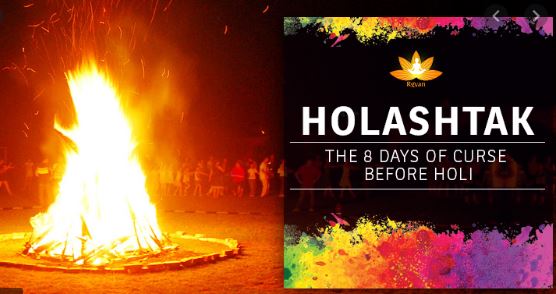Holashtak- The Days of Penance prior to Holi; dos and don’t ; significance; date and muhurt
The observance of Holashtak is associated with the colourful festival of Holi. It refers to the eight day period just before the celebrations of Holi.
The period of Holashtak is considered to be inauspicious by most of the Hindu communities in Northern parts of India. According to the Purnimant calendar followed in North India, Holashtak starts from the ‘Ashtami’ (8th day) of the ‘Shukla Paksha’ (the period of bright fortnight of moon) and continues till the ‘Purnima’ (full moon day) of the ‘Falgun’ month.
The last day of Holashtak, that is, Falgun Purnima is the day for observance of Holika Dahan in most of the regions. In the Gregorian calendar, Holashtak falls during the months of mid-February to mid-March. Holashtak is celebrated with full enthusiasm in Haryana, Punjab, Madhya Pradesh, Bihar, Himachal Pradesh and other regions of North India.
Holashtak 2020 started on March 03, Tuesday and will end with Holika Dahan on March 09, Monday
The observance of Holashtak is associated with the colourful festival of Holi. It refers to the eight day period just before the celebrations of Holi.
The period of Holashtak is considered to be inauspicious by most of the Hindu communities in Northern parts of India. According to the Purnimant calendar followed in North India, Holashtak starts from the ‘Ashtami’ (8th day) of the ‘Shukla Paksha’ (the period of bright fortnight of moon) and continues till the ‘Purnima’ (full moon day) of the ‘Falgun’ month.
The last day of Holashtak, that is, Falgun Purnima is the day for observance of Holika Dahan in most of the regions. In the Gregorian calendar, Holashtak falls during the months of mid-February to mid-March. Holashtak is celebrated with full enthusiasm in Haryana, Punjab, Madhya Pradesh, Bihar, Himachal Pradesh and other regions of North India.
Holashtak 2020 started on March 03, Tuesday and will end with Holika Dahan on March 09, Monday
Rituals during Holashtak:
With the start of Holashtak, people start decorating the branch of a tree using colourful pieces of clothes. Each individual ties a piece of cloth on the branch and it is then finally buried in the ground. Few communities even burn these pieces of clothes during Holika Dahan.
Also on the beginning day of Holashtak, Falgun Shukla Paksha Ashtami,
and a place is chosen for Holika Dahan. On each day small sticks are
gathered and collected at the place of Holika Dahan.
The 9-day festival of Holi finally comes to end on the day of ‘Dhuleti’.
The day of Holashtak is ideal for doing ‘Daan’ or offering donations. During this time one must generously donate clothes, grains, money and other essential commodities as per their financial status.
Important Timings On Holashtak
| Sunrise | March 03, 2020 6:50 AM |
| Sunset | March 03, 2020 6:27 PM |
| Ashtami Tithi Begins | March 02, 2020 12:53 PM |
| Ashtami Tithi Ends | March 03, 2020 1:50 PM |
Related Events
| Holashtak End | 2020 Mar 09 Monday |
Significance of Holashtak:
Holashtak is a word made from two different words, ‘Holi’ and ‘Ashtak’ (8th day) implying the eight days of Holi. In the Hindu community, the period of Holashtak is considered to be unfavourable.
Therefore auspicious ceremonies like marriages, child naming sanskar, housewarming and any other 16 Hindu Sanskars or rituals are avoided during this period. In some communities people even do not prefer starting a new business venture during the Holashtak period.
This is due to the fact that during the period of Holashtak, Hindu planets like Sun, Moon, Mercury, Jupiter, Mars, Saturn, Rahu and Venus undergo transformations.
The period of Holashtak is considered to be very favourable for Tantriks as they can easily achieve their goals through ‘Saadhna’. The celebrations of Holi start with the beginning of Holashtak and come to an end on ‘Dhuleti’, the day following Falgun Purnima.
Holashtak festival dates between 2017 & 2027
| Year | Date |
|---|---|
| 2017 | Sunday, 5th of March |
| 2018 | Friday, 23rd of February |
| 2019 | Thursday, 14th of March |
| 2020 | Tuesday, 3rd of March |
| 2021 | Monday, 22nd of March |
| 2022 | Thursday, 10th of March |
| 2023 | Monday, 27th of February |
| 2024 | Sunday, 17th of March |
| 2025 | Friday, 7th of March |
| 2026 | Tuesday, 24th of February |
| 2027 | Tuesday, 16th of March |
Holi 2020: Know what to do and what not to do in Holashtak
Holi 2020: Holashtak is considered from Ashtami to Purnima date of Shuklapaksha of Falgun month. This year Holashtar starts from 3rd March and will be till 9th March. According to astrology, in the eight days before this full moon date, there is some nervousness and discomfort in the brain. With this, the effects of grief, depression and despair begin to increase, so no work should be done for these eight days.
What not to do in holashtak
During this period, any type of mangal work is considered taboo. Just as the eclipse and lunar eclipse occur, Holashtak is celebrated eight days before Holi festival. During this time, planetary entry, marriage, shaving, debt deeds, Upanayan rites, naming rituals and other auspicious works should not be done.
What to do in holashtak
The period of Holashtak is the best time for bhajan and worship. In this period, there is a law to keep wood at the site identified for Holika Dahan so that it can be burnt in Holika. Ganga baths and donations should also be done during this period. To worship Holika from the day of Holashtak, the place of Holika is cleaned and buried with dried stems, dried wood, dry grass and Holi, after worshiping it. On this day, eating mango manjari and sandalwood has great significance.




